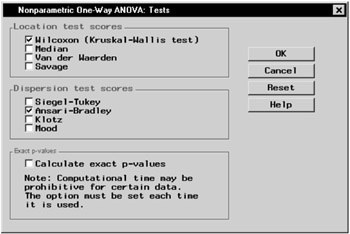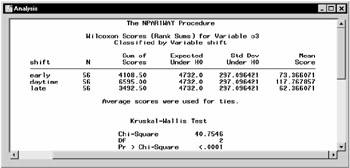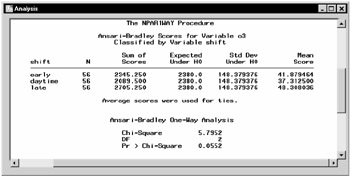Nonparametric One-Way Analysis of Variance
|
| < Day Day Up > |
|
In statistical inference, or hypothesis testing, the traditional tests are called parametric tests because they depend on the specification of a probability distribution (such as the normal) except for a set of free parameters. Parametric tests are said to depend on distributional assumptions. Nonparametric tests, on the other hand, do not require distributional assumptions. Even if the data are distributed normally, nonparametric methods are often almost as powerful as parametric methods.
The Nonparametric One-Way ANOVA task enables you to perform nonparametric tests for location and scale when you have a continuous dependent variable and a single independent classification variable. You can perform a nonparametric one-way ANOVA using Wilcoxon (Kruskal-Wallis), median, Van der Waerden, and Savage scores. In addition, you can test for scale differences across levels of the independent variable using Ansari-Bradley, Siegal-Tukey, Klotz, and Mood scores. The Nonparametric One-Way ANOVA task provides asymptotic and exact p-values for all tests for location and scale.
For example, consider the air quality data set (Air), described in the section "The Air Quality Data Set" on page 270. Suppose that you want to perform a nonparametric one-way ANOVA and also test for scale differences for ozone levels across shift periods.
Request the Nonparametric One-Way ANOVA
To request a nonparametric one-way ANOVA, follow these steps:
-
Select Statistics → ANOVA → Nonparametric One-Way ANOVA...
-
Select o3 as the dependent variable.
-
Select shift as the independent variable.
Figure 10.10 defines the nonparametric one-way ANOVA model.

Figure 10.10: Nonparametric One-Way ANOVA— Main Dialog
Request Nonparametric Tests
You can use a nonparametric test for location to determine whether the air quality is the same at different times of the day. The Kruskal-Wallis test is a commonly used nonparametric technique for testing location differences and is produced using Wilcoxon scores.
The box-and-whisker plot in Figure 10.9 indicates that ozone levels may be more variable during the daytime shift than during the early shift or at night. You can use the Ansari-Bradley test to test for scale differences across shifts.
To request the Kruskal-Wallis and Ansari-Bradley tests, follow these steps:
-
Click on the Tests button in the main dialog.
-
Select Wilcoxon (Kruskal-Wallis test) in the Location test scores.
-
Select Ansari-Bradley in the Dispersion test scores box.
Figure 10.11 displays the Tests dialog with the Wilcoxon (Kruskal-Wallis) and Ansari-Bradley tests selected. Click OK in the Nonparametric One-Way ANOVA dialog to perform the analysis.

Figure 10.11: Nonparametric One-Way ANOVA— Tests Dialog
Figure 10.12 displays the Wilcoxon scores and Kruskal-Wallis test results. The table labeled "Wilcoxon Scores (Rank Sums) for Variable o3" contains the sum of the rank scores, expected sum, and mean score for each shift. The daytime shift has a mean score of 117.77, which is higher than the mean scores of both the early and late shift. The "Kruskal-Wallis Test" table displays the results of the Kruskal-Wallis test. The test statistic of 40.75 indicates that there is a significant difference in ozone levels across shift times (the p-value is less than 0.0001).

Figure 10.12: Nonparametric One-Way ANOVA— Kruskal-Wallis Test Results
Figure 10.13 displays the results of the Ansari-Bradley test. The Ansari-Bradley test chi-square has the value of 5.80 with 2 degrees of freedom, which is not significant at the α = 0.05 level. Since the p-value is just slightly higher than 0.05, there is moderate evidence of scale differences across shift times.

Figure 10.13: Nonparametric One-Way ANOVA— Ansari-Bradley Test Results
|
| < Day Day Up > |
|
EAN: 2147483647
Pages: 116